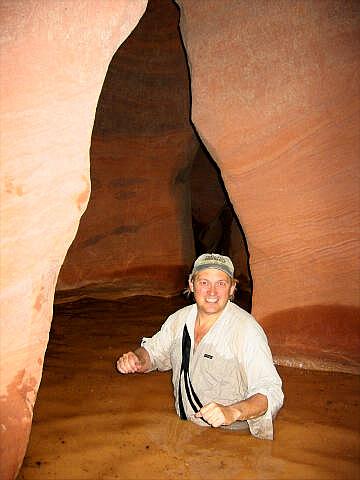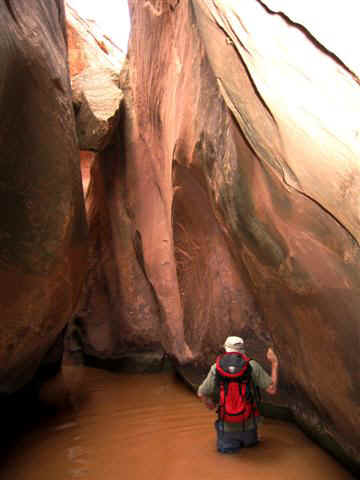[ Homepage ] [ Introduction ] [ Warning ] [ Ratings ] [ Ethics ] [ Feedback ] [ Updates ]
Something you should probably know about me is that I am a minimalist. I believe that speed is my most potent weapon and commonsense my most valuable tool when descending a canyon. This doesn't mean I descend canyons in high gear all the time. It means that I can travel quickly over a long distance when the need arises. All the gear mentioned by brand name is the gear that I use. Some was purchased because it was the best gear available, some was purchased because it was on sale, some was purchased because it was in stock the day that I needed it, and some was given to me. I purchased most of this gear with my hard-earned dollars, an I have no reason to promote one product over another. Often there are other products, which are just as good or better. That being said, if someone would like to send me a bunch of free gear I would be happy to use it if I find it valuable. Damn, I sure hate begging unless sex is involved. Possibles Bag No mountain man worth his buckskins would go into the wilderness without his "Possibles Bag". The term "Possibles Bag" comes from the American Mountain Men of the early 1800's. My "Possibles Bag" is a 6" X 6" stuff sack, which I carry on all my outdoor adventures. This bag contains the items I need to survive. My "Possibles Bag" contains Aspirin, prescription pain killers, assorted Band-Aids, knife with a 3" blade, two butane lighters, 10-feet of 3mm accessory chord, toilet paper, duct tape, small bottle of bug juice, chapstick, Coleman emergency bivy bag, A small LED headlamp (mine is a Petzl Tikka), small bottle of sun screen lotion and water purification tablets. Most of the items in my Possibles Bag are self explanatory. I switched from a space blanket to a real bivy bag after a couple of forced bivouacs. The sun screen lotion can be used to treat rashes along with offering sun protection. I use duct tape for blisters or hot spots because it stays on in water unlike most band-aids. Duct tape can also be used to suture deep cuts or attach splints in an emergency. I like to think of duct tape as my all-in-one first aid kit. I carry two butane lighters so I can break one open and use the fuel inside to start a fire in wet or snowy conditions. FootwearCanyoneering puts harsh demands on your footwear. Improper or ill fitting footwear can ruin and enjoyable adventure. The following are a few suggestions for footwear. Clothing Being wet, uncomfortable, cold and miserable all day long is not the ingredients for a grand adventure. Wearing the correct clothing has nothing to do with looking good. Well, maybe a little but having the correct clothes will make the adventure a more enjoyable affair. Backpack I use the Black Diamond Ice Pack with about ten 1/2" drain grommets mounted in the bottom. The grommets drain the water out of the pack quickly upon exiting a pothole. Any pack in the 2500 to 3000 cubic inch range which fits you will work well. A pack with few or no pockets is preferred since that allows less places for water to become trapped. The big secret to a canyoneering backpack is placing grommets in the bottom to drain the water out quickly. A Grommet kit is available in most fabric stores for around $10. I suggest placing at least one grommet in each bottom corner of the pack and several across the bottom. Grommets placed in the bottom have a tendency to become clogged with items inside the pack such as your dry bag sitting on top of them, which is the reason for grommets in the bottom corners. If the idea of placing grommets in an existing backpack sounds like a bunch of work you can always buy a canyoneering backpack from Imlay Canyon Gear. I would suggest the "Kolob" as the most versatile model and best all around choice. If I were buying a new backpack for myself today this is the pack I would purchase. Dry BagsI stuff everything I do not want wet into drybags, which I than place inside my backpack. I have found that several smaller dry bags are more versatile than one large drybag. Some canyoneers prefer to carry gear inside a keg. While this method keeps gear dry I have found that the kegs cause holes in your backpack where it rubs against sandstone. The kegs also do not collapse when stuck in a skinny slot. I don't like kegs, I prefer drybags, that is a personal choice. Some guys like blondes and some like brunettes, that is a personal choice, get the picture? Wetsuit I am quite warm blooded, or maybe I just have a bunch of body fat, but I don't get cold easy. I own four different cold water items and by wearing them in different combinations I am able to stay warm in any condition. Navigation  Good
navigation gear is essential if you don't want to get lost. Rappelling into the wrong drainage is a major cause of
canyoneering rescues. Many of the best canyons are located in very isolated
locations. No signs, no trails and no directions are very common. Good
navigation gear is essential if you don't want to get lost. Rappelling into the wrong drainage is a major cause of
canyoneering rescues. Many of the best canyons are located in very isolated
locations. No signs, no trails and no directions are very common.
Hydration System I often use a 100 ounce Camelback bladder system which I place inside my backpack. I mix the bladder 50/50 with water and Gatorade. I have found I stay hydrated better with a bladder system than if I use water bottles. The Gatorade is added to re-supply missing electrolytes and improve the taste. If I am not using a bladder system I just toss a couple of bottles of Gatorade in my pack. I love Gatorade and when combined with beef jerky I can live for days. As you might have noticed I'm not a real gourmet in the outdoors. RopeIt seems that I hear dozens of opinions each day on which rope is best or why I should use X-brand rope. One guy is telling me I should only rappel on static rope while his best friend is screaming in my other ear that dynamic is the only way to go. Well here is the truth about canyoneering ropes. As a general rule thicker ropes are safer than thin ropes. Thick ropes are easier to rig, but they weigh more. Any good safe climbing rope will work just fine until you have enough experience to gain a preference. By the time you have a preference your first canyoneering rope will be worn out and need replacing anyway. There is one important and often overlooked item to consider when purchasing a canyoneering rope. Bright colors look better in photographs. Don't laugh, it's true and worth considering when you have an array of colors to select from. Rope color never entered my thought's until I was doing some rappel's for a professional photographer and he kept asking me to rig the "yellow rope" to enhance his photographs. At the moment my personal canyoneering rope arsenal contains a 9mm x 60-meter static rope, which is often combined with a 6mm x 60-meter pull chord. The third rope in my arsenal is a 8mm x 100-foot static rope. This is my favorite rope since it is light and versatile. This rope gets more use than any other rope. It is easy and fast to use on all the short drops which you will frequently encounter during your canyoneering adventures. I also have a 8mm x 60-foot static rope that is used in canyons with only very short rappels. The best value on canyoneering ropes are usually found at Imlay Canyon Gear. The ropes are designed by a Utah canyoneer and made specifically for canyoneering. It's always a nice bonus when you can support one of our own in addition to obtaining a quality piece of gear. Technical GearBuying the correct technical gear is where many beginners get lost. They have a tendency to ask, read, and loose as much sleep as possible wondering what style of technical gear is right for them. They than take their credit card down to the local climbing store and spend all of next year's disposable income on equipment that somebody in an internet chat room recommended based on hearsay. Only to find out half of the gear that they bought is really worthless and that "...only 'Posers' buy that stuff".
The equipment list above should give you a good idea of what I carry and why. Every canyon is different so I can not provide a standard gear list. If the canyon is difficult it is not uncommon to carry ten slings of different lengths and 100 feet or more of webbing. Clothing changes with the weather and season. Wetsuit's vary with amount of water, time of year and depth of slot. Ropes are a big variable with many canyons requiring only a 60-foot rope while others require 600 feet of rope. Before you spend your hard earned coin on fancy gear you should seriously consider receiving professional instruction. Good schooling is a powerful weapon and difficult to beat when everything goes to shit in a deep, narrow slot. Without a doubt the most valuable piece of gear you can carry is "Commonsense". Never, under and circumstance or condition enter a canyon without it. [ Homepage ] [ Introduction ] [ Warning ] [ Ratings ] [ Ethics ] [ Feedback ] [ Updates ] © Copyright 2000-, Climb-Utah.com |


